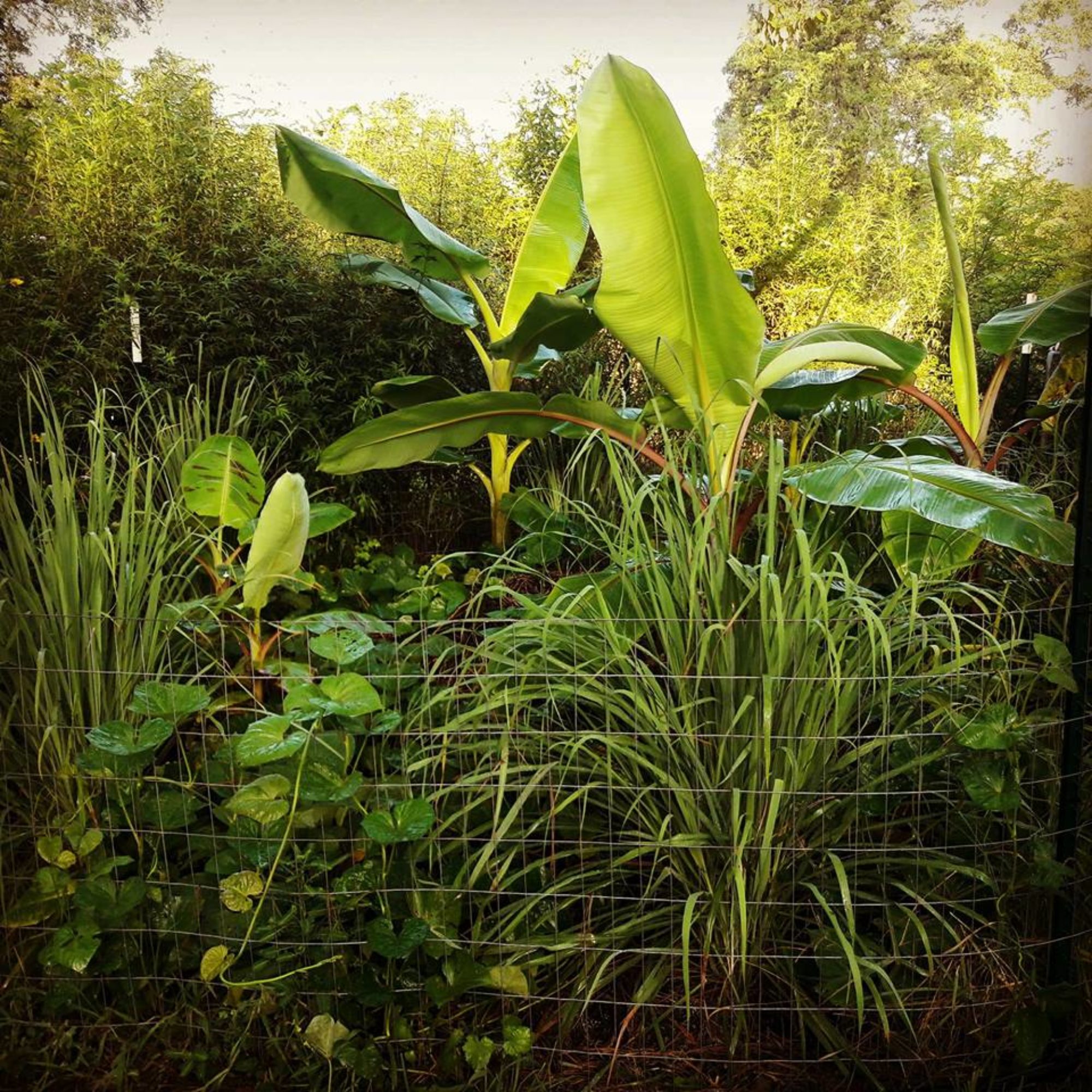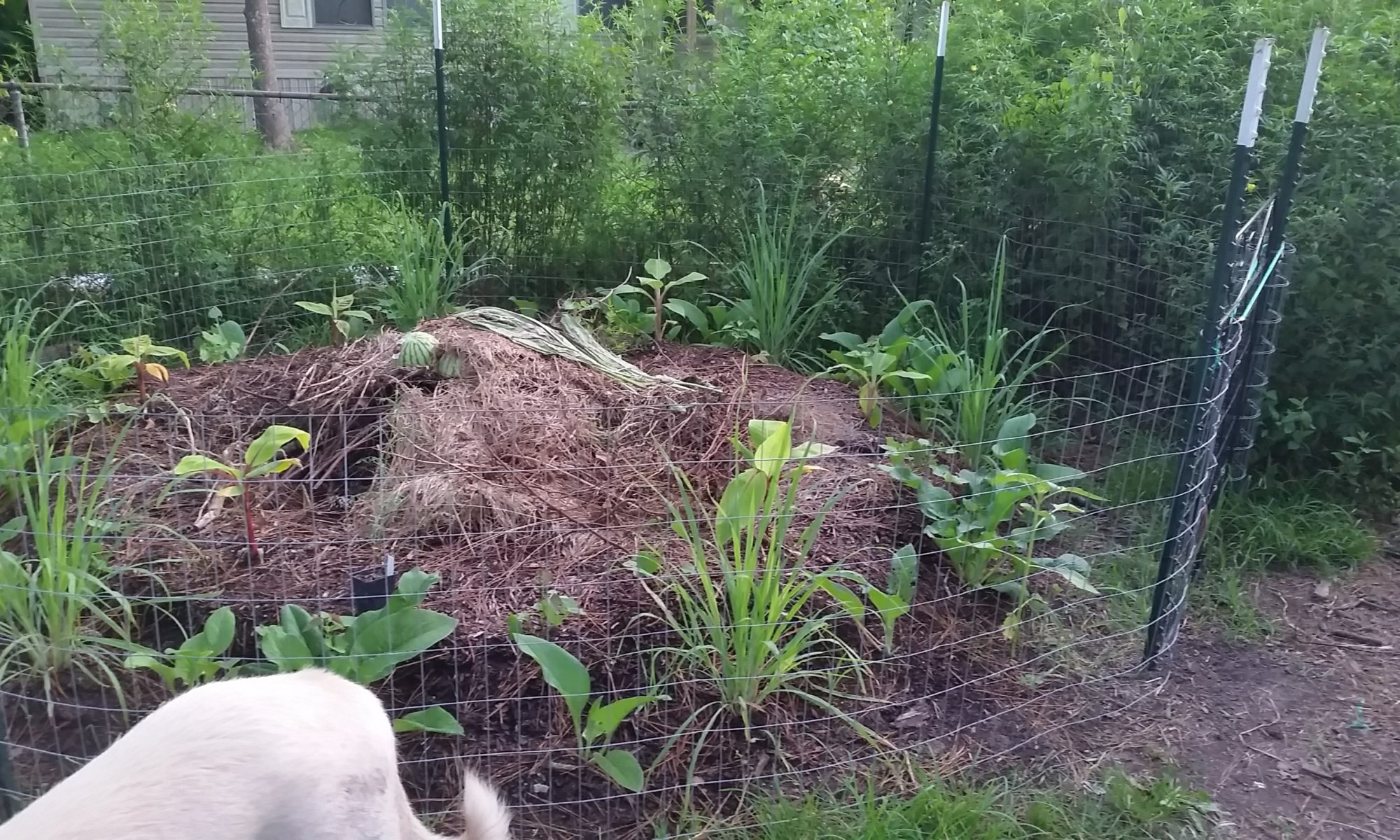Have you ever heard of a banana circle? It was a recent discovery of mine and one I wondered about for quite some time before deciding to actually install one myself. Bananas are cheap so I figured it would be best to dedicate the room to other types of fruit trees instead of bananas that only produce once and then die. However, there are many benefits to having a banana circle that may entice you to consider one or more into your permaculture design.
So what exactly is a banana circle you may be asking?
Well, a banana circle is much more than a group of bananas planted in a circle. A banana circle is a permaculture designed guild that incorporates many functions, many products and many benefits! A banana circle is an installation that usually takes up about a 6-foot wide circle and is planted with bananas and/or plantains around the circumference of that circle. Also grown with the bananas are sweet potatoes, comfrey, taro, lemongrass and sometimes other specimens as well as a compost pit. More on that later.
What are the benefits of a banana circle?
Well, there are many! First, is the beneficial relationships between the different species of plants. The bananas obviously produce delicious fruit, more so than just the Cavendish you would buy at your local grocer. The beauty of the banana tree is also very relaxing, giving the feeling you’re at a tropical resort, especially when the bananas are flowering/producing! The lovely scent of the lemongrass when brushed against and the beauty and tastiness of the sweet potato greens as the sprawl and climb up the bananas as well as the tropical look of the taro and the medicinal and mineral uses of the comfrey are all just a few of the benefits. Don’t forget the mulch pile as well. Having a place to throw all your excess trimmings is a great convenience!
You can think of the banana circle as a type of 3 sisters garden in the fact it each plant provides benefits to the others. The bananas provide much-needed shade for the comfrey and taro and a climbing surface for the sweet potatoes. The comfrey provided much need nutrients and mulch to the bananas as well as a weed barrier to the circle. The lemongrass also provides mulch and weed barrier and they both have their uses outside the circle as well. Comfrey is a great medicinal and lemongrass is a great culinary herb. The sweet potato provides a living mulch to the system, shading the soil and shading out weeds while being a delicious green vegetable to eat as well. The taro is an added bonus and an alternative to the white potato that is not as healthy.
Let’s talk about the actual build.
So you’ve decided you want a banana circle. How do you go about building it? There are many different opinions on this but the best way is the dimensions listed above. The reason for this is 2 fold. The first reason is so that the bananas have room to grow without crowding out other elements in the system and the second is so that the compost/mulch pit has enough mass to heat up and quickly decompose the material being input. This compost pit will not be turned and you do not have to worry about the C:N (carbon-nitrogen) ratio as you would normally in a typical compost manufacture. Another reason for this diameter is so that you can easily reach the middle from anywhere outside the circle. The other thing to realize is that I said mulch pit, not mulch pile. This 6-foot circle needs to be dug out 3 feet deep. So watch me as I build the banana circle.
The first thing you need to do is choose the location. Bananas are heavy feeders and need constant moisture. They do best in with partial shade – full sun which basically means they’ll do great in any light situation, however, they will grow faster with more sun although you must realize that the more sun they’ll receive the more water they’ll need due to their extremely large leaves. I chose a location that is low-lying and downstream from my rabbits and chickens in order to receive plenty of nutrient-filled water. The circle is also under a huge male mulberry tree and will only receive evening sun. So far this location has done absolutely fantastic.

The next step is to clear the area and mark the layout of the circle so you know where to dig. The shape does not have to be a perfect circle, just a closed loop, use whatever space you’ve got.

After that, start digging!

After that, just keep digging!






A very important aspect of a banana circle is the mulch pit as I stated earlier. Now it should turn into a mound. The mound should be so big it is spilling over the sides of the outer ring. This mound will be continously added to as more mulch becomes available from other parts of your property.




Other things to know about banana circles.
As stated in 1 of the captions above, bananas are not actual trees, but rather the world’s largest herbs and they are all sterile at this point in history so they cannot propagate by seed. They are like a pineapple in that they will grow up, mature and produce fruit only once, then die. Before dying, however, they will give off multiple pups. There are 2 types of pups, called water suckers and sword suckers. They are easily identifiable because sword suckers leaves look like, well, swords! Water suckers have very broad leaves very young and do not grow as fast as sword suckers. Water suckers should be cut off the corm and discarded or repotted and grown out to eventually produce a sword sucker but that process takes a very long time.
Maintenance of the circle is very interesting as what we are going to do is have the bananas walk around the circle. What?! Bananas walk? Yes, they will! I told you about the suckers that come up from around the base of the mother plant. We are going to pick a direction for the bananas to walk, either clockwise or counter-clockwise. Whenever a sword sucker comes up on the side we choose, we will leave it and whenever a sucker comes up on the opposite side, we will remove it and pot it up for sale or transplant. In this way, the bananas will continuously “walk” around the circle indefinitely!
Watch the video below for a visual about the differences…
Another thing to know…
is that we should really only leave the mother and a daughter plant living in the circle, with perhaps a grand-daughter plant as well if you wish but just the mother and daughter is advisable. When these plants are established and the original plants have produced, it is time to chop and drop the older banana plants into the mulch pit. This chop and drop technique is a permaculture technique that follows the 3rd ethic, which is Return of Surplus.
Now you might be thinking, what about the sweet potatoes? You said something about green vegetables. That’s right, the sweet potato greens are extremely delicious, very nutritous and will thrive in the heat that these tropical plants love and where growing any type of standard leafy greens like lettuce, kale and spinach just won’t survive the summers. However, we all know and love the sweet orange flesh of a sweet potato tuber. These are not harvested at a specific time like you normally would in a garden bed but instead are harvested either as needed, a few at a time or when actually propagating the sword suckers because you will be digging in the same area as the potatoes, you will incidentally be harvesting these sweet potatoes all year.
So, there you have it, everything needed to know to start your own banana circle. Go forth and make your own tropical paradise in your backyard!
By the way, this can also be done with papayas, coconuts, palms and many other types of guilds, although some will be much larger than the standard banana circle.
[TheChamp-FB-Comments]




